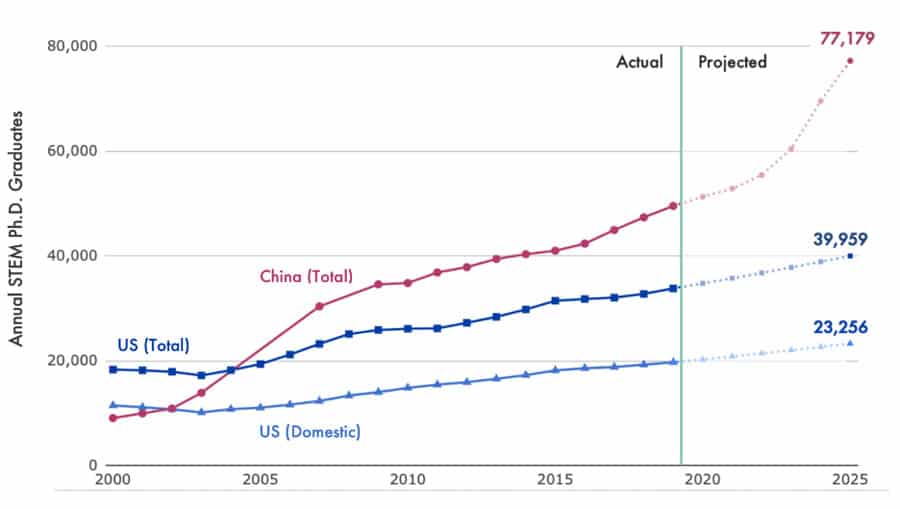US: More international STEM students will be granted three-year OPT
- In keeping with President Biden’s stated foreign policy goal of nurturing international education and enrolments, eligibility will be expanded for the US’s popular Optional Practical Training (OPT) programme
- Programme eligibility will be extended to accommodate students from a wider range of STEM fields
- The government is also making It easier for international graduates of STEM programmes to obtain Green Cards
- Given China’s heavy investment in STEM and scientific innovation, experts consider it a matter of urgency for the US to keep up
Effective immediately, the US’s Optional Practical Training programme (OPT) is expanding to allow more international students – in more STEM-related fields of study – to remain in the country for three years after graduation.
The US administration announced that the Departments of State and Homeland Security (DoS and DHS) are leading this expansion, as well as several other policy changes, to “advance predictability and clarity for pathways for international STEM scholars, students, researchers, and experts to contribute to innovation and job creation efforts across America.”
The new push on opening work and immigration opportunities for STEM students comes as concerns are mounting in the US about China’s rapid progress in nurturing STEM talent.
22 new STEM-related fields added
An OPT permission of three years post-graduation is now available to F-1 students in 22 new fields of study, which are detailed here in a Federal Registry notice. Many of the new fields of study are related to climate change and environmental protection, as well as data sciences and analytics. The 22 fields were chosen from a total nomination pool of 97 fields, and the American public may continue to nominate other fields of study for possible consideration.
J-1 STEM students and graduates also eligible
There is good news for J-1 (exchange) students in STEM fields as well: The Department of State’s Bureau of Educational and Cultural Affairs (ECA) is leading a two-year initiative (2021/22 and 2022/23) allowing degree-seeking J-1 students and graduates in STEM fields to remain in the US for three years. Prior to this, the cap has been 18 months of work allowance for J-1 students. For details (including how to apply and whom to contact with questions), please visit this DoS webpage.
In addition, an “Early Career STEM Research Initiative” has been announced:
“The US Department of State’s Bureau of Educational and Cultural Affairs (ECA) is announcing an “Early Career STEM Research Initiative” to facilitate non-immigrant…exchange visitors coming to the United States to engage in STEM research through research, training or educational exchange visitor programs with host organizations, including businesses.”
For details and FAQs, please consult this DoS webpage.
More generous guidelines for O-1A eligibility
The government is also working to make it easier for STEM graduates and other non-immigrants to remain in the US on an O-1A visa (reserved for “people with extraordinary ability” in certain areas). The DHS is issuing an update to its guidance for how applicants for O-1A can be evaluated going forward:
“The new update provides examples of evidence that may satisfy the O-1A evidentiary criteria and discusses considerations that are relevant to evaluating such evidence, with a focus on the highly technical nature of STEM fields and the complexity of the evidence often submitted.”
Easier pathway to Green Cards
Securing a Green Card is no easy feat for most applicants and usually requires employer sponsorship – unless applicants are awarded a “national interest waiver,” which allows them to petition for their Green Card themselves based on “exceptional abilities.” Effective immediately, foreigners with exceptional STEM talents and skills are priorities for securing a national interest waiver:
“USCIS is now clarifying how the national interest waiver can be used by science, technology,
engineering, and mathematics (STEM) graduates and entrepreneurs, as well as the significance of letters from governmental and quasi-governmental entities.”
The government notes, “This effort is consistent with the Biden-Harris Administration’s priorities to restore faith in the legal immigration system.”
Concerns about China
The new push on opening work and immigration opportunities for STEM students comes as concerns are mounting in the US about China’s rapid progress in nurturing STEM talent. A report published last year by Georgetown University’s Center for Security and Emerging Technology (CSET) found that China is already outpacing the US in graduating STEM PhDs and that by 2025, China will produce twice as many STEM PhDs as the US. The report notes that,
“Between 2016 and 2019, the number of students entering STEM doctoral programmes at Chinese universities increased nearly 40%, from 59,670 to 83,134.”

What’s more, the quality of Chinese institution from which STEM graduates are emerging is often excellent. The most elite universities in China are called “Double First Class” (DFC) institutions, of which there are 42. These institutions receive the most funding and the Chinese government is heavily invested in them. Most of them are ranked in the top 500 globally and half of them are in the top 200. And here’s where the quality of graduates comes in: the Georgetown University report notes that “a little under half of all Chinese PhD graduates have come from “Double First Class” universities” and many more come from the next class of university (where quality and funding are also high).
A matter of urgency
China’s acceleration in generating graduates primed for scientific and data-based innovation contrasts with a multi-year trend in the US of limited growth (or even decline) in the number of international students enrolling in US institutions. This has consequences for STEM innovation in particular, given that 54% of international students are in STEM fields, primarily in engineering (21%) and math and computer science (20%). As an article published in 2020 in The Atlantic points out,
“These students go on to work for artificial-intelligence companies, logistics firms, biotech labs—or start their own. When given the opportunity, they prefer to stay in the United States. More than 80 percent of international doctoral students in artificial intelligence, for example, remain in the country after graduation, according to a December report from the Center for Security and Emerging Technology.”
Building on momentum
A 2021 IIE survey found that 860 universities reported a 68% increase in international student commencements in the fall of 2021 – a sea change from the 46% decline they reported in Fall 2020. The US administration is working to support the building up of international enrolments again, issuing a joint statement last summer saying that this goal was a “foreign policy imperative.”
For additional background, please see:
















